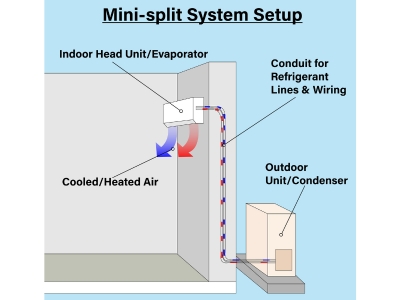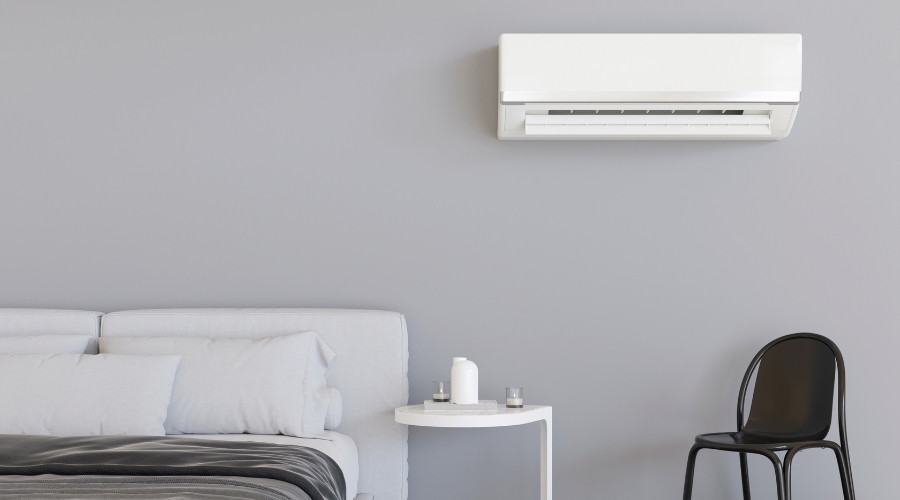HVAC contractors in Sun Prairie, WI, answer frequently asked questions about mini-splits.
Sun Prairie, United States - July 13, 2023 / Cardinal Heating & Air Conditioning /
Did you know that according to Wisconsin's Focus on Energy website, heating and cooling accounts for nearly half of your household energy usage? This means that a heating and cooling system is the highest energy user in a typical household.
In a bid to reduce costs on utility bills, there has been an increase in demand among homeowners for cost-effective heating and cooling alternatives. One that could offer both efficiency and comfort while allowing them to save significantly on energy bills.
Today, there's no smarter, more cost-effective way to keep your home cool than investing in a ductless mini-split system. Because of its design and features, you can save up to 30% on your household utility bill through mini-split systems (as compared to traditional systems).
In this article, you'll learn what mini-splits are and whether they are worth the hype. You'll also get answers to some of the most frequently asked questions (FAQs) about this high-energy efficient ductless heating and cooling system.
What Is a Mini-Split System?
 A mini-split system is an alternative to the traditional HVAC system. It's an innovative heating and cooling system that got its name from its design and how it functions.
A mini-split system is an alternative to the traditional HVAC system. It's an innovative heating and cooling system that got its name from its design and how it functions.
The term "mini'' refers to the smaller size and compact design of the system as compared to the traditional HVAC system. The smaller size makes this unit great for mounting on the wall or ceiling, while the compact design makes the units easy to install and allows placement flexibility.
The term ''split'' in a mini-split system implies that the unit is separated/split into two main functional components. The refrigerant lines and electrical wiring link these two components, creating a ''split'' system. The two components are:
- 1. An outdoor unit consisting of the compressor and condenser, which circulate refrigerant and heat extracted, respectively
- 2. An indoor unit containing the evaporator which delivers conditioned air to specific areas or zones
It's worth noting that a mini-split system can come in two distinct configurations depending on the number of indoor units connected to the outdoor unit. When it comes to this end, the choice of your mini split may depend on your desired level of climate control and the size of your space.
The two system configurations are:
- 3. Single-zone mini split—consists of one indoor unit for one outdoor unit
- 4. Multi-zone mini split—consists of multiple (2-4) indoor units for one outdoor unit
In short, ''mini-split'' refers to a small, compact heating and cooling system with outdoor and indoor components. It's also known as a ductless mini-split system and offers an individualized level of climate control to specific rooms or zones within a building.
Where Can a Mini-Split System Be Installed?
Thanks to its small, compact design, you can install a mini-split system in various locations within your home. However, the location and style of the mini-split are crucial to receiving optimal conditions. Based on the method of installation, let's take a look at some common types of mini splits out there:
1. Wall-Mounted Mini Split
This is the most popular and straightforward installation option for a mini-split unit. As its name implies, it involves mounting or placing a mini split high on the wall (just below the ceiling). This installation option or method is ideal if you want the unit to deliver conditioned air throughout the room. It's commonly used in residential settings.
2. Floor-Mounted Mini Split
This is an alternative installation method for spaces with limited wall space, or ceilings that are too low. Here, a mini-split is installed on a wall at or near floor level. This mini split type is ideal for rooms with large windows or spaces where a low-profile unit is desired (such as in sunrooms or offices).
3. Ceiling-Cassette Mini Split
These mini splits are installed on the ceiling. Its installation involves hanging the unit from the ceiling using brackets or chains. This particular installation option allows a wider circulation of conditioned air than most other options. It’s ideal where there’s limited wall space. Many homeowners who don’t want their HVAC system to take up wall space or want to keep their indoor units out of sight might prefer this option.
How Efficient Is a Mini-Split System?
Mini-split systems are particularly efficient in many ways compared to traditional HVAC systems. According to Energy.gov, traditional HVAC systems use ducts and, as a result, account for over 30% of energy consumption to provide the heating or cooling needed. They often feature centralized units that deliver heating and cooling to the entire house, resulting in energy losses in unoccupied rooms.
On the other hand, mini-split systems operate without the need for ducts. And this helps eliminate the energy loss associated with ductwork. This feature (combined with other features of a mini split) allows the units to deliver more efficient heating and cooling. It will also result in potential energy savings, reducing household energy consumption by up to 30% compared to traditional HVAC systems.
People who want to meet their household heating and cooling needs demand the most energy-efficient heating and cooling options. And as a result, they're opting for mini splits to reduce energy consumption and lower utility bills, saving big on energy costs.
Is a Mini-Split System Loud?
Mini-split systems are designed to provide unobtrusive cooling and heating. Mini-splits (indoor units) typically have noise reduction features and perform their operations at lower decibel levels.
Some modern mini-split systems are equipped with sound-dampening technology to make them extremely quiet. These units also feature advanced fan designs that help minimize noise levels when the units are in use.
However, their outdoor unit does produce some noise during operation. But the noise level is generally lower than what you may experience from larger central conditioning units.
Can I Use a Mini-Split System for Both Heating and Cooling?
 Yes, mini-split systems are designed to provide two modes of operation: cooling mode (for cooling) and heating mode (for heating). They use heat pump technology which allows the units to transfer heat from the outdoor unit to the indoor unit for heating or from the indoor to the outdoor unit for cooling. It’s important to note that in cold climates you will need a supplemental source of heat when the temperatures are particularly frigid. Any temps below -14° and the heat pump will not be capable of pulling enough ambient heat out of the air to produce heat, and you will need to rely on a backup heat source.
Yes, mini-split systems are designed to provide two modes of operation: cooling mode (for cooling) and heating mode (for heating). They use heat pump technology which allows the units to transfer heat from the outdoor unit to the indoor unit for heating or from the indoor to the outdoor unit for cooling. It’s important to note that in cold climates you will need a supplemental source of heat when the temperatures are particularly frigid. Any temps below -14° and the heat pump will not be capable of pulling enough ambient heat out of the air to produce heat, and you will need to rely on a backup heat source.
How Many Mini-Split Systems Do I Need to Be Effective?
The total size of the space will determine the size and number of mini splits you'll need for optimal heating and cooling of your home. This also includes the power capacity needed for the systems. In general, the larger the space where you need these systems, the larger/more systems you'll need for adequate coverage.
Homes with larger spaces featuring multiple rooms or zones may require multi-zone mini splits to effectively heat and cool the entire space. A single-zone mini split is generally only used to heat or cool one room and is great for additions to your home such as sunrooms where you might not want to spend the extra money on installing ductwork.
In measuring your home's size and layout, you need to consider factors such as your:
- space's square footage
- ceiling height
- number of windows
- insulation levels
These factors will assist you in the proper estimation of the number and placement of indoor units needed for your space. An HVAC professional best handles these calculations.
Number of Rooms
Suppose you have multiple rooms or areas in your home that require different temperature settings. In that case, a separate indoor unit for each room or zone is required for individualized adequate climate control.
Your Load Calculation
Load calculation (aka heating and cooling load calculation) is a way used to determine the heating and cooling requirements of a home, building, or space. This is estimated in British Thermal Units (BTUs) or kilowatts (kW).
This process involves evaluating certain factors affecting the heat gain or heat loss in the area where heating and cooling are required. This helps determine the ideal capacity or number of mini splits your home needs to maintain desired climate settings.
These factors may include:
- climate
- ventilation
- building orientation
- windows and doors
- insulation
- occupancy and internal loads
HVAC professionals would consider these factors when calculating the load calculation using manual methods or specialized software. The results of your home load calculation will guide the HVAC professional in determining the appropriate number and capacity of mini splits needed.
How much does a mini-split system cost to install?
The installation cost of a mini-split system fluctuates based on the type of system (single zone or multi-zone) and the number of units needed.
Typically, a single zone system tends to average at approximately $9,000, covering both the components and the installation. On the other hand, a multi-zone system's total cost can reach up to $15,000, depending on the number of units being installed. While they may appear somewhat expensive initially, these systems prove beneficial over time by reducing energy expenses annually.
Mini-split system Installation in Sun Prairie, Wisconsin.
Talk to one of our professionals today at Cardinal Heating and Air Conditioning. We're ready to answer all your questions about mini-split systems and air conditioning in Sun Prairie, Wisconsin, and its neighboring counties.
You can contact Cardinal Heating & Air Conditioning at (608) 837-9367 or send us a text via our website, and we'll answer all your questions.

Contact Information:
Cardinal Heating & Air Conditioning
3361 Brooks Dr.
Sun Prairie, WI 53590
United States
Cardinal Heating & Air Conditioning Team
(608) 837-9367
https://www.cardinalhvac.com/
Original Source: https://www.cardinalhvac.com/press-releases

